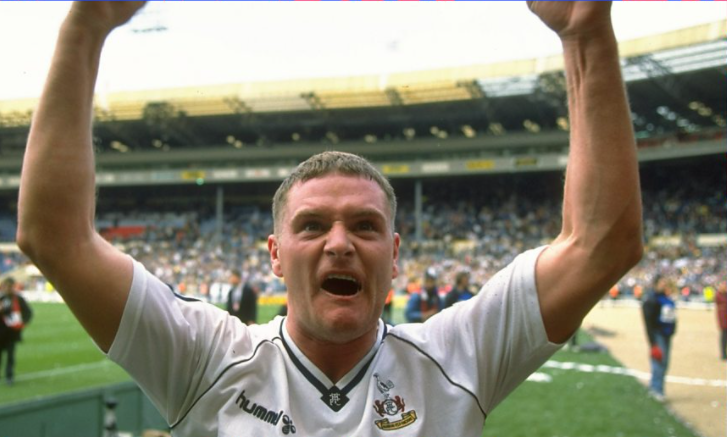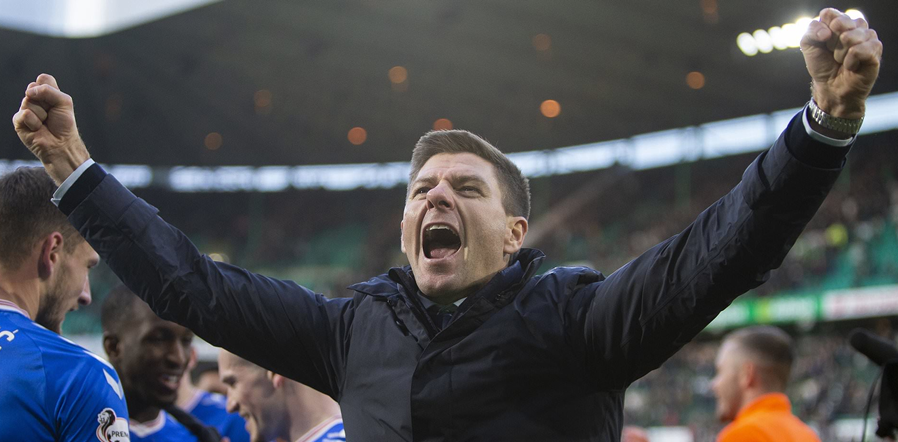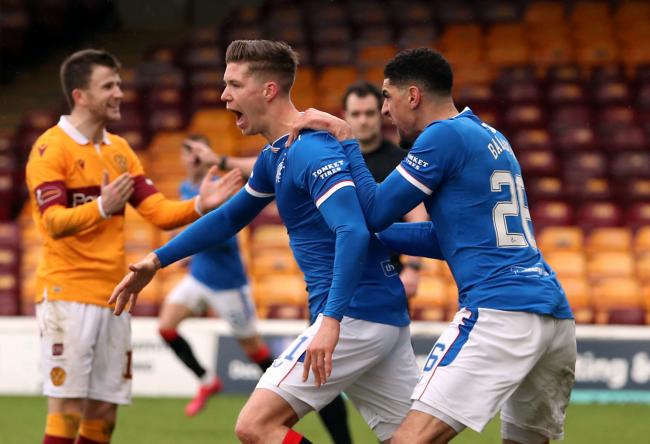The battle fever is well and truly on at this point. This is one of those brilliant times of the season where the social media timeline is filled with old videos of Old Firm goals, tackles, interviews and songs that just get you in the mood for Saturday. These are the weeks we do it for, as fans. This is what it’s all about.
So, in the spirit of the week we’re brining you The Road to Rangers but not as you know it. In this edition, we’re going through the decades looking at Old Firm goalscorers that have also scored in some of Europe’s other big derbies on their Road to Rangers. From London to Lombardy, from the Riviera to Rapid Vienna, these are the stories of the big players turning up in the big occasions.
Ladies and Gentlemen, welcome to The Road to Rangers – Derby Days.
Mark Hateley: Derby della Madonnina – AC Milan 2 – 1 Inter Milan [Serie A] – 28th October 1984
Named after the statue of the Virgin Marry in capital of Lombardy, The Derby della Madonnina (also known as the Derby di Milano or ‘The Milan Derby’) is arguably the most recognisable derby in football, let alone Italy. The Milan Cricket and Football Club, founded by a group of Englishmen led by Alfred Edwards and therefore named the Anglo-Saxon ‘Milan’ instead of the Italian ‘Milano’, are the oldest club in the city. Not long after however, a second side was formed by the local Milanese population who wanted a side of their own split with Milan to form Football Club Internazionale Milano (note the use of ‘Milano’ instead of ‘Milan’).
This is a rivalry based on class first and foremost, with Milan being a club of the working-class Milanese population who mainly worked in the blue collar jobs and were ‘accustomed to using a screwdriver’. Internazionale on the other hand were seen as the club of the middle classes in the city who were more accustomed to the professional lifestyle. One of the most intriguing aspects of this rivalry is the location of where it is played, with both Milan sides residing in the famous Stadio Giuseppe Meazza – more commonly referred to as the San Siro – since 1947. The added spice of each side wanting to assert their dominance on their city and their turf is what makes this derby so special.
The first derby between the two sides was played in 1908, with Milan winning 2-1 on the day but Inter have had the rub of the green since then, winning 82 derbies compared to Milan’s 76 and scoring eight more goals overall. A large part of that success against their rivals came between 1978 and 1984, where Milan failed to beat their city rivals for six consecutive years. On the 28th October 1984, Mark Hateley would stop the Rossoneri rot.

The reason for lengthy wait was due to Milan suffering one of the worst periods in their history, with their demotion to Serie B due to a match-fixing scandal in 1980 and a subsequent relegation again to Serie B in 1982 and on that day in 1984, after Inter had taken the lead after just 10 minutes, things were looking bleak for Milan. They however equalised 23 minutes later to make it 1-1 and on 63 minutes, Mark Hateley beat Inter defender Fulvio Collovati in the air to give Milan one of the most famous derby victories in their history. The former Milan Right-Back and coach Mauro Tassotti, who was also playing that day, describes Hateleys goal wonderfully:
“Before the joy came the amazement. An incredible deadlift, which showed how Mark possessed truly rare timing and strength. I still have in my eyes the wonder of all of us who were around him; the applause, the enthusiasm but also the sincere compliments we paid him for an incredible athletic gesture”.
Hateley is still considered Milan legend for that goal alone and has been immortalised in the clubs history, so much so that before their 3-0 triumph over Inter in 2016, 32 years on, the Milan fans unfurled a massive tifo recreating the famous picture of Hateley’s headed effort.

Paul Gascoigne: North London Derby – Tottenham 3 -1 Arsenal [FA Cup Semi-Final] – 14th April 1991
We’re closer to home for this derby, its one which I’m sure many of us have a keen interest in which includes a player near and dear to our hearts.
The most intriguing aspect of this derby is it was never started as such, aside from basic London rivalry. Games between the two sides date back as far as 1887 with Greater London the home of Arsenal at the time. Even as late on as 1909, as the sides met for the first time in the league, this still wasn’t considered to be the derby we know today.
It was four years later however that situation changed, as Arsenal put their tanks on Tottenham’s lawn by moving just four miles away from White Hart Lane, pitching up at Highbury.

The rivalry exploded when, after the first World War, the First Division was to be expanded by two sides. Chelsea took the first slot and Arsenal took the second after securing eighteen votes. This enraged Tottenham who cried foul play and alleged that the Arsenal Chairman Sir Henry Norris was handing out cash for votes. With the bitterness came the North London Derby we know today.
One of the most compelling instalments of the rivalry came the 1991 FA Cup Semi-Final, with both sides heading to Wembley bidding for a place in the Final. Arsenal were the overwhelming favourites for a match that nobody expected Terry Venables Tottenham to win. Paul Gascoigne returned to the side after a spell out through injury to provide the spark that set this Semi-Final alight.

His 35-yard free-kick in the fifth minute took everybody in the stadium by surprise, including Barry Davies who was on commentary duty for the BBC:
“He’s not going to have a go from there… he is you know… OH THAT IS SCHOOLBOYS OWN STUFF!”
A superb strike by Gazza had given spurs the lead, which would then be doubled just five minutes later with Garry Lineker grabbing the first of two goals for himself and despite Alan Smith pulling one back before half time Lineker grabbed his second on the 78th minute to seal the win.
Despite Lineker’s brace however, it was Gascoigne who grabbed all the plaudits. Stuart Jones waxed lyrical about his performance in his match report for The Times, saying:
“Touching heights of brilliance rare even by his elevated standards, Gascoigne blocked Arsenal’s path to a historic double and ushered Tottenham Hotspur to the final… His contribution, though it lasted scarcely an hour, bordered on the sensational. Show him a spacious stage, turn up the lights, cover the event with television cameras and Gascoigne remains one of the games most enthralling entertainers”.
Owing to the magnitude of the victory and the fact that Tottenham would go on to beat Nottingham Forrest in the final, the 14th April has been immortalised in Tottenham’s history as St. Hotspur day in celebration of the result.
Dado Prso: Derby de la Cote d’Azur – OGC Nice 1 – 2 AS Monaco [Ligue 1] 29th March 2004
When you think of Monaco, you think of wealth and luxury – Casino’s, yachts and the world’s most famous Grand Prix race are to name but a few things that accurately depict the lavish lifestyle in the principality. When you think of Nice, you think of the gorgeous sights of the French Riviera and the beating heart of French commerce, an area where the upper-classes have historically called their own.
So, it might come as a surprise to learn that Monaco and Nice play host to one of the most violent derbies in France. However, the Derby de la Cote d’Azur (also known as the French Riviera Derby) is just that – as fans have invaded the pitch and frequently fought with the police in previous meetings as well as the opposing sets of fans. The rivalry has grown from being about geography to being about titles, with both sides having achieved success historically. However, in recent times it has been Monaco who have had the better of the times as they have reached the Champions League later-stages on multiple occasions, even reaching the final in 2004. It is in that season that we shall be discussing the derby.
Dado Prso announced himself on the European stage in the champions league group stages of the competition in 2003, scoring four goals to help Monaco dismantle Deportivo La Coruna 8-3 in a wild game at the Stade Louis II. Prso would go on to play in the final of the competition as well but could do nothing as Jose Mourinho’s Porto ran out 3-0 winners.

However, it wasn’t just on the big European nights that Prso would come alive for Monaco, he done it in the big domestic games of the season as well and none come bigger than away to rivals Nice. After Nice holding this high-flying Monaco side to a 1-1 draw earlier in the season, one might have thought a relative upset could be on the cards when they took the lead after just 11 minutes. It was then up to Dado Prso to stamp his mark on the game in the 35th minute as he put a right-footed effort past Damien Grégorini in the Nice goal. Prso would then need to be taken off just 7 minutes later with injury which sadly ended his contribution in this derby. Nevertheless, Monaco scored to make it 2-1 just before half-time and held on to make it a famous win at the home of their rivals.
This was to prove to be Prso’s final Derby de la Cote d’Azur as he would leave Monaco in the summer for Rangers where he would carry on his habit of popping up with important goals in derby matches.
Nikica Jelavic: Wiener Derby – Rapid Vienna 2 – 0 Austria Vienna [Austrian Bundesliga] – 14th March 2010
The Wiener Derby (or the Vienna Derby in English) is the second most-played derby in world football, second only to the Old Firm itself, as neither side have been relegated from Austria’s top-flight. Like all the derbies that have been mentioned, this rivalry is also based on geography. Both Rapid and Austria began their lives in Western Vienna before Austria eventually moved to the south of the city. Their fans are primarily divided as such, with Rapid Vienna fans residing mainly in the North and Western part of the city while fans of Austria Vienna come from the West.

Rapid are the older of the two sides, having been founded in 1899, 12 years before their rivals. Their early development Is reflected in the rivalries head-to-head standings, with Rapid winning 137 of the 238 meetings in total, 20 more than Austria. Furthermore, they boast the most Austrian top-flight titles with 32, eight more than Austria. The derby has been seen as one oftThis is another derby with a history of fan-violence, with four policemen being injured in 2007 and a game needing to be abandoned in 2011 due to Rapid fans invading the pitch.
The actions on the pitch haven’t been much better either, as Austria Vienna goalkeeper Joey Didulica was fined €60,000 for jumping and hitting Rapid striker Axel Lawaree in the face with his knee in a match in 2005. The fine was for physical injury as the result of negligence as it was judged that Didulica could have done more to prevent the injury which lead to a broken nose and contusions for Lawaree.
By 2010, RB Salzburg had began to take the mantle as Austria’s finest away from the two sides in Vienna and would go on to narrowly win the league that season by a single point ahead of Austria Vienna and three points ahead of Nikica Jelavic’s Rapid. It was in March of that year the two Vienna powerhouses met still chasing Europe and yet another title.
It was a cagey start to the match with little action in the first half but a penalty to Rapid in the 67th minute after Austria defender Jacek Bak brought down Mario Konrad in the box gave the home side the opportunity to take the lead and Steffen Hofmann made no mistake from twelve yards. Just 9 minutes later, Jelavic gave Rapid a firm grip on the three-points with just 14 minutes remaining as he struck home to give Rapid a two-goal advantage. From there, the Austria Vienna players lost their discipline and ended the game with nine men after receiving two red cards in the final three minutes of the game.

From Rapid, Jelavic would move to Rangers and like those before him continue to score the big goals at the big moments in the derby. However, Jelavic had notably already gained experience scoring against our city rivals while still playing for Rapid Vienna, as he bagged three goals and an assist in two games against Celtic in the 2009/10 Europa League. Goals against the same opposition came in no short supply once the Croatian pitched up in Govan, of course.
However, the biggest Derby in the world is fast approaching for our current crop of players and the battle fever is well and truly taking hold at this point. None of these players mentioned in the article can influence what happens on the pitch come Saturday lunchtime, but if this current side channel the spirt of anyone of them, then I fancy us.
Until next time, thank you. C’mon the Rangers!
Ross Hutton : @rsjh0501





